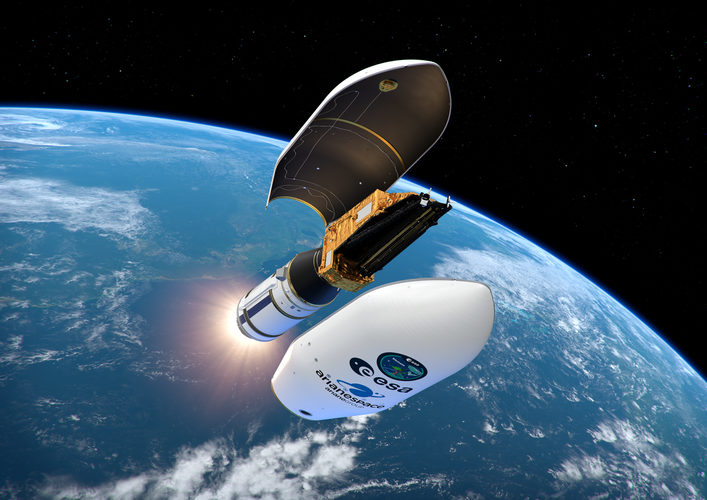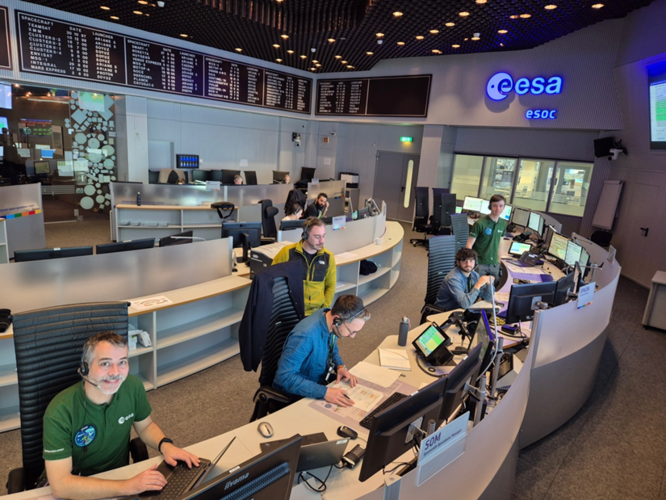
Copernical Team
Shockwave mapping reveals hidden plasma structures near Earth
 A team of Australian scientists has harnessed the flickering of a nearby pulsar to map invisible plasma structures within our local galactic neighborhood, offering unprecedented insight into the turbulent medium between stars. This achievement, made using the MeerKAT radio telescope, illuminates the plasma dynamics inside a rare bow shock structure and redefines our understanding of the Local Bu
A team of Australian scientists has harnessed the flickering of a nearby pulsar to map invisible plasma structures within our local galactic neighborhood, offering unprecedented insight into the turbulent medium between stars. This achievement, made using the MeerKAT radio telescope, illuminates the plasma dynamics inside a rare bow shock structure and redefines our understanding of the Local Bu Galaxies surged in size during early universe growth phase
 A new astronomical survey led by the University of Kansas using the James Webb Space Telescope (JWST) has delivered fresh insight into galaxy evolution during the universe's peak star-forming era known as "cosmic noon," which occurred roughly 2 to 3 billion years after the Big Bang.
The MIRI EGS Galaxy and AGN (MEGA) survey reveals that half of all the stars in today's galaxies were born d
A new astronomical survey led by the University of Kansas using the James Webb Space Telescope (JWST) has delivered fresh insight into galaxy evolution during the universe's peak star-forming era known as "cosmic noon," which occurred roughly 2 to 3 billion years after the Big Bang.
The MIRI EGS Galaxy and AGN (MEGA) survey reveals that half of all the stars in today's galaxies were born d China selects global payloads and opens lunar samples to foreign scientists
 China has announced the selection of 10 international payloads for its upcoming Chang'e 8 lunar mission, underscoring its commitment to global collaboration in space science. The China National Space Administration (CNSA) revealed that the chosen experiments span 11 nations and regions, including a specialized project from the International Society for Terrain-Vehicle Systems.
Among the se
China has announced the selection of 10 international payloads for its upcoming Chang'e 8 lunar mission, underscoring its commitment to global collaboration in space science. The China National Space Administration (CNSA) revealed that the chosen experiments span 11 nations and regions, including a specialized project from the International Society for Terrain-Vehicle Systems.
Among the se Rocket Lab to Conduct Hypersonic Test Flight Under MACH-TB 2.0 Program
 Rocket Lab USA, Inc. (Nasdaq: RKLB), a key provider of launch services and space systems, has secured a new contract to launch a full-scale hypersonic test flight on behalf of the U.S. Department of Defense. The mission, commissioned by Kratos under the MACH-TB 2.0 initiative, will utilize Rocket Lab's HASTE vehicle and is scheduled to lift off from Launch Complex 2 at Wallops Island, Virginia,
Rocket Lab USA, Inc. (Nasdaq: RKLB), a key provider of launch services and space systems, has secured a new contract to launch a full-scale hypersonic test flight on behalf of the U.S. Department of Defense. The mission, commissioned by Kratos under the MACH-TB 2.0 initiative, will utilize Rocket Lab's HASTE vehicle and is scheduled to lift off from Launch Complex 2 at Wallops Island, Virginia, Three Chinese astronauts blast off for Tiangong space station
 A Chinese rocket carrying three astronauts to the country's space station blasted off from its remote launch site Thursday, the latest milestone in Beijing's race to become a leading celestial power.
Beijing has pumped billions of dollars into its space programme in recent years in an effort to achieve what President Xi Jinping describes as the Chinese people's "space dream".
The world's
A Chinese rocket carrying three astronauts to the country's space station blasted off from its remote launch site Thursday, the latest milestone in Beijing's race to become a leading celestial power.
Beijing has pumped billions of dollars into its space programme in recent years in an effort to achieve what President Xi Jinping describes as the Chinese people's "space dream".
The world's Sentinel-1 captures ground shift from Myanmar earthquake

On 28 March 2025, a powerful magnitude 7.7 earthquake struck central Myanmar, sending shockwaves through the region. While the country is still dealing with the devasting aftermath, scientists have used radar images from the Copernicus Sentinel-1 satellites to reveal a detailed picture of how the ground shifted as a result of the quake – offering new insights into the mechanics of the tectonic Sagaing Fault and the scale of the seismic rupture.
Solar Orbiter’s widest high-res view of the Sun
 Image:
Solar Orbiter’s widest high-resolution view of the Sun
Image:
Solar Orbiter’s widest high-resolution view of the Sun Watch Biomass launch live

ESA's Biomass mission is on the launch pad at Europe’s Spaceport in Kourou, French Guiana. Don’t miss the live coverage of liftoff on Tuesday 29 April, on ESA WebTV. Coverage will start at 10:55 CEST with commentary live from Kourou and ESA’s European Space Operations Centre in Germany. The Vega-C rocket carrying Biomass is scheduled for liftoff at 11:15.
Final preparations for Biomass operations

As the launch of the Biomass satellite approaches, the excitement is palpable at ESA’s European Space Operations Centre (ESOC) in Darmstadt, Germany. Over the winter months, a dedicated team has been meticulously preparing for the satellite's critical "Launch and Early Orbit" phase (LEOP).
New study unveils volcanic history and clues to ancient life on Mars
 In a groundbreaking study co-authored by a Texas A and M University scientist, researchers have revealed new insights into the geological history of Mars' Jezero Crater, the landing site of NASA's Perseverance rover. Their findings suggest that the crater's floor is composed of a diverse array of iron-rich volcanic rocks, providing a window into the planet's distant past and the closest chance y
In a groundbreaking study co-authored by a Texas A and M University scientist, researchers have revealed new insights into the geological history of Mars' Jezero Crater, the landing site of NASA's Perseverance rover. Their findings suggest that the crater's floor is composed of a diverse array of iron-rich volcanic rocks, providing a window into the planet's distant past and the closest chance y 
